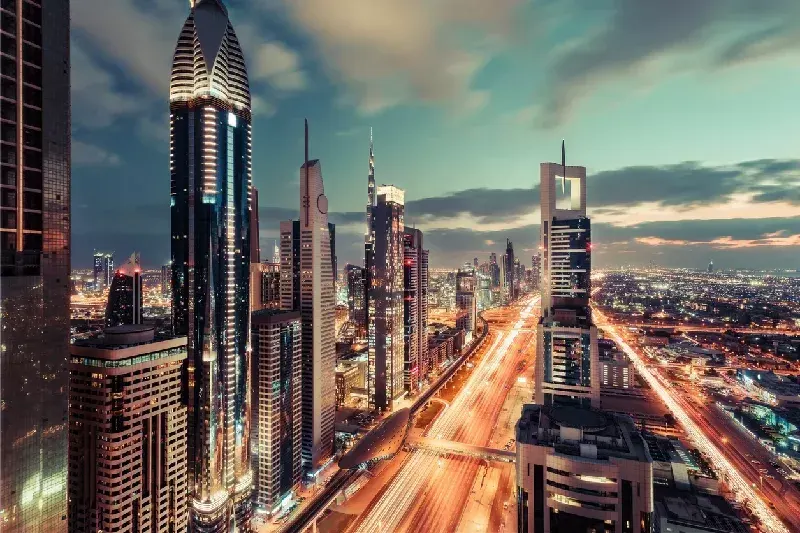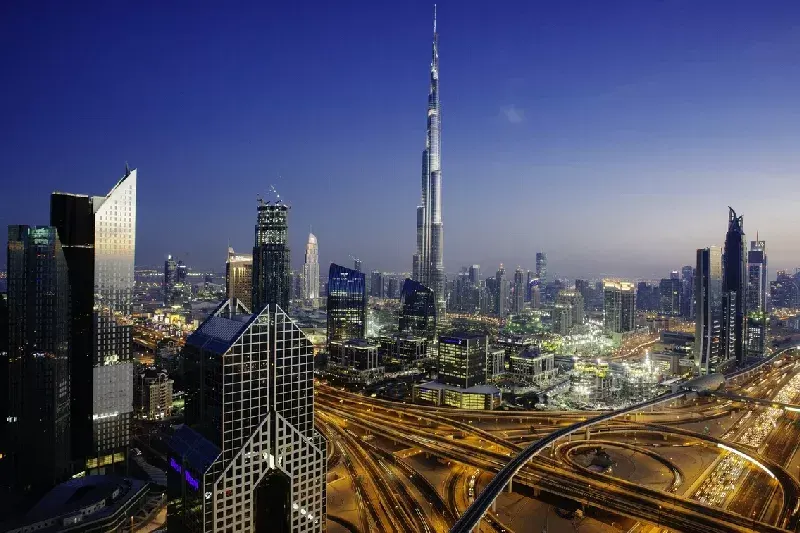The Real Story of Sheikh Zayed Road (SZR)
Sheikh Zayed Road is Dubai’s main highway, lined with skyscrapers, major landmarks, and key business hubs.

Having your full Dubai Experience when visiting the UEA definitely would take its best shape when choosing your accommodation located at the heart of the city, reaching ever step at the City of Gold.
Deserts sands whispered tales of struggle on the first routes of Sheikh Zayed Road in 1971. Motorists traveled on treacherous beach-lined roads from Abu Dhabi to Dubai, their vehicles most often giving way to the boundless expanse of unmarked earth. The majestic 558.4-kilometer road is today the UAE's longest road, perfectly connecting the Abu Dhabi-Saudi border to the furthest point of Ras Al Khaimah-Oman border.
The history of the road itself unwinds in decades of drive and progress. Gigantic skyscrapers now overshadow the skyline where once only wind-swept dunes existed, providing Dubai with its most vibrant street. Sheikh Zayed Road is tangible evidence of the UAE's phenomenal ascent, an echo of the nation's own growth from simple desert roots to its current place as a dazzling city that captivates the globe.

Early Days of Sheikh Zayed Road
Desert winds swept across broad unpaved roads between Dubai and Abu Dhabi before the UAE came into being. Abu Dhabi's tiny fleet was a relic of the past. Brave explorers crossed these lands with nothing but fading tire marks etched into endless sand as their map.
Desert Tracks in the 1960s
Savvy tourists discovered nature's gem - the hard sands of beach roads between Dubai and Ras Al Khaimah. Drivers carefully charted perilous paths along the coasts between Dubai and Abu Dhabi. British military cartographers plotted these primitive boulevards on their 1955 maps of the Trucial States without knowing they were charting the germinal roots of the contemporary highways.
Construction of the first paved road
Dubai transport infrastructure took its first roots with Al Seef Road, carefully surveyed in Bur Dubai under strict municipal oversight in 1960. Sheikh Zayed Road's master plan of ambition was born in 1971 by the joint vision of Abu Dhabi and Dubai rulers. Nine years of toil were rewarded with 22 kilometers of pioneering road stretching purposefully from west to east.
Early Challenges for Travelers
Desert travel tested the mettle of each traveler. Adventurous types faced:
- Alone breakdowns in endless dunes
- Uncharted tracks of intrigue
- Treacherous wreckage near Jebel Ali with exploding tires by the dozen
Night hid these roads, and nighttime rides were particularly dangerous. The Dubai-Abu Dhabi ride took four precious hours - a testament to stamina over today's speed.
Political undertones were around the birth of this desert artery. King Faisal Bin Abdul Aziz Al Saud, British Prime Minister Harold Wilson, and Egyptian President Jamal Abdul Nasser were all characters in this drama in the making. British officials observed the road's development with suspicion, leading to sensitive diplomatic maneuvering.
1980 was a triumph - Sheikh Zayed bin Sultan Al Nahyan and Sheikh Rashid bin Saeed Al Maktoum's dream materialized in the shape of a one-lane tarmac joining their emirates. Until 1990, though, photographs revealed nothing more than a lonely strip of asphalt bisecting golden dunes. This humble beginning would develop into the UAE's most vital transportation lifeline, a road you will pass by during your Dubai tour.
The Role of the Road in Dubai's Development
Stretching majestically for 558.4 kilometers from Al Silah to Ras Al Khaimah, the E11 highway is one of the UAE's greatest engineering achievements.
Connection to Abu Dhabi
Twin titans of the UAE, Abu Dhabi and Dubai, found their riches bound together in this remarkable artery. Much more than just concrete and asphalt, this vital corridor harmonizes economic possibilities between these mega cities. With each expansion, each upgrade, the unseen fibres binding these urban giants together grow stronger, nurturing the prosperity they share.
Impact on Trade Routes
Stats tell a staggering tale of global coverage. Chinese exports flow like historical silk roads into Emirati ports, two-thirds of their European, Middle Eastern, and African exports going this way.These figures bring stories to life about Sheikh Zayed Road's pivotal role in global commerce.
Architectural Evolution Along the Road
Sheikh Zayed Road stretches out as a living museum of dreamscapes in architecture. Each building reads a chapter in Dubai's remarkable history towards the clouds, beginning with a single tower to challenge the desert sky. A Complete Guide about Dubai unveils the stories behind these soaring landmarks, tracing the city's transformation into a global icon of innovation and ambition.
First Skyscrapers Emerge
Dubai World Trade Center, initially Sheikh Rashid Tower, pierced the sky in 1979 at a height of 149 meters with 39 floors. This solitary giant rose from barren sands, the first vertical dream of Dubai along Sheikh Zayed Road. Desert winds swept against its solitary form, nature's sole companion in those initial years.
1999 marked Dubai's real rise to the heavens, building momentum through 2005. In a decade, 73 stunning buildings rose above 200 meters, creating one of the world's most breathtaking skylines. Emirates Towers appeared in 2000, their silver aluminum and bronze glass facades shimmering with desert light. These towering twins held the title of Middle East's tallest until 2009, their graceful forms setting new benchmarks for architectural greatness.
Modern Architectural Landmarks
Sheikh Zayed Road now serves as Dubai's poetry in steel and glass. Gaze upwards to:
- Al Yaqoub Tower's 328-meter tribute to London's Big Ben, standing 72 stories tall in the sky
- HHHR Tower's blue landmark, signifying its status as the world's sixth tallest residential marvel at 318 meters
- Index Tower's bold statement dominates the Financial District, where innovation merges with artistic expression
Dubai's architectural symphony keeps going on - 50 skyscrapers rise above construction sites while 127 await their turn to touch the skies. Soon enough, a beautiful 102-storey marvel will be the next-door neighbor to the Museum of the Future with the world's highest outdoor sky pool hanging threateningly 500 meters above ground.
Apart from the vertical success, cultural heritage pervades each design. Dubai Metro stations on Sheikh Zayed Road reflect the emirate's pearling past in elegant shell forms, shiny aluminum crowns, and crystalline glass walls. The stations reconcile past and future, paying respect to traditional lineage while looking towards tomorrow's opportunities.
Customize Your Dream Vacation!
Get in touch with our local experts for an unforgettable journey.
Plan Your TripLife on Sheikh Zayed Road UAE Today
Sheikh Zayed Road is rumbling with city life, glass-sheltered housing pockets lining up shoulder-to-shoulder along with business titans. And here, Dubai's dream for today's lifestyle becomes a breathtaking reality.
Transport Options
Twelve grade level tarmac highways form Dubai's main transportation backbone, most busy from 7:00 to 9:00 am and 5:00 to 7:00 pm. Dubai Metro's Red Line glides quietly alongside, offering serene transportation above the busiest avenue. Bus stops are situated discreetly about the area with RTA cabs, Uber, and Careem cars running in a constant circle day and night, allowing uninterrupted mobility as part of city life.
Business Centers
Corporate excellence finds its home along this prestigious corridor. Business centers flourish here, offering spaces that range from intimate offices to expansive floor plates. Modern workspaces boast:
- Lightning-fast internet infrastructure
- Sophisticated reception facilities
- State-of-the-art meeting spaces
- Dedicated administrative teams
- Adaptable payment structures
Landmarks Along Sheikh Zayed Road
Sheikh Zayed Road is more than just Dubai’s main artery, it’s a journey through the city's most iconic landmarks. Along the way, as you ride on this vibrant highway, you will pass by the tallest building in the world, Burj Khalifa, and the visually striking Museum of the Future building in the torus shape of its future one. Dubai's first skyscraper, the Dubai World Trade Centre, is an example of the ambitions of earlier days, whereas the stunning Emirates Towers are symbols of the prowess of the building skills of the emirate.
Shopaholics will spot Dubai Mall, where there are limitless upmarket brands and things to do, and farther down, a glimpse of glinting Burj Al Arab in the distance. The highway also parallels Dubai Marina, a high-rise residential coastline district with thriving nightlives. Sheikh Zayed Road is not just a highway, it's a tour of the history, current, and future of Dubai.

Desert sands yielded to the designs of architecture, and steel and glass monoliths now march this ancient boulevard. Commercial empires flourish where camels once ambled, as world commerce flows through this artery with inexorable power. Land prices skyrocket ever higher, testament to the corridor's fatal allure to dreamers and constructors.
A new dawn breaks for tomorrow—architectural wonders still to be imagined and commercial triumphs still to be won stand in the wings along this fabled highway. From desert track to Dubai's pulsating lifeline, Sheikh Zayed Road is an enduring tribute to how unbending will and master planning can not only build a road, but can remake the destiny of a nation.
If you're ready to experience this remarkable transformation firsthand, explore our Dubai tours from Australia and discover how history and modernity collide in dazzling harmony.
There are Many More Things to Do in Dubai, Inquire Now and Plan Memorable Dubai Tours!
Sheikh Zayed Road is Dubai’s main artery, lined with iconic skyscrapers, luxury hotels, and major business hubs, making it the city's most dynamic boulevard.
Sheikh Zayed bin Sultan Al Nahyan was the founding father of the UAE, known for his visionary leadership in uniting the nation and transforming it into a global powerhouse.
The road is home to landmarks like the Burj Khalifa, Dubai World Trade Centre, Museum of the Future, and Emirates Towers, alongside shopping malls and fine dining spots.
Sheikh Zayed Road spans approximately 558 km, running from Abu Dhabi through Dubai and extending towards the northern emirates.


























































